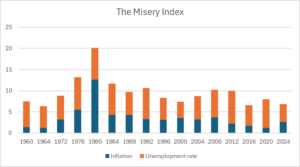September 13, 2024
In 1980 Ronald Reagan brought the term “misery index” into political debates. The concept is simple, it’s the sum of the unemployment rate and inflation rate over the last year. It’s not obvious that these two numbers should have the same importance, and they certainly are not the only measures that matter in evaluating the economy, but they do provide an interesting snapshot.
Anyhow, Reagan could point to a misery index that was over 20 percent as the election approached. The inflation rate was in the double-digits and unemployment was still high as a result of a steep but short recession in the spring. The high level for the misery index was a theme Reagan hit on repeatedly in the campaign.
The misery index has largely faded from use over the last four decades, but it is still interesting to see what this simple snapshot shows. Here’s the picture since 1960.

Source: Bureau of Labor Statistics and author’s calculations.
As can be seen, the index for 2024 is near the low point for this sixty-four-year period. (I used the data through August for both inflation and unemployment.) At 6.8 percent, it is 0.2 percentage points higher than it was in 2016 and 0.5 percentage points higher than in 1964, the low point for the period.[1]
In fact, there is a decent chance that it will end up being lower than the 2016 measure by election day. Inflation is clearly headed lower, driven by slower rental inflation and also a recent drop in gas prices. It is likely that the CPI will show a year-over-year inflation rate that is at least 0.2 percentage points lower than the 2.6 percent rate reported through August. If the unemployment rate doesn’t rise, this would leave us tied with the 2016 measure for the second-lowest misery index during this period.
At least by the Reagan index measure, the Biden-Harris economy looks pretty good.
[1] I have used October as the reference month, even though the unemployment data sometimes would not be available by election day and the CPI never would be. The logic is that voters actually experience October unemployment and inflation by election day, even if they haven’t seen the report on these measures from the Bureau of Labor Statistics.







Comments